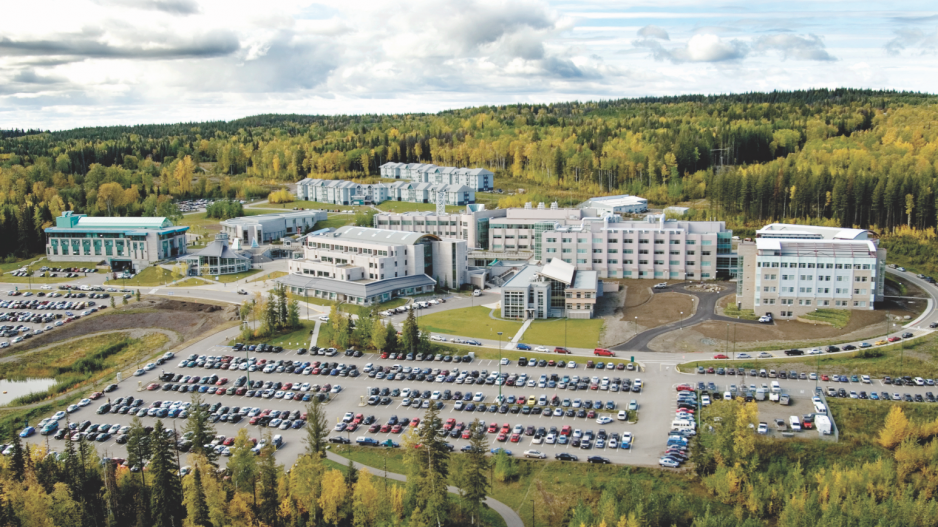The post-secondary school year began in the north last week with a kickoff event for the 25th anniversary of University of Northern British Columbia (UNBC) – an institution that’s consistently ranked among Canada’s top three small universities.
I think it’s also the most beautiful campus in the province.
According to Ken Coates, the Canada research chairman in regional innovation at the University of Saskatchewan, the UNBC campus is also “the only building truly designed for a northern setting in the whole country.”
An example of true northern architecture.
He should know.
In the ’90s, just as the university started awarding degrees, Coates was the academic vice-president at UNBC.
In 1992, Coates and fellow researcher and frequent co-author William Morrison published The Forgotten North, a highly readable 130-page summary of the history of Canada’s provincial norths, stretching from Labrador to Prince Rupert.
Coates has since become a leading national voice in northern development and circumpolar affairs.
Ahead of UNBC’s 25th birthday, I wanted to talk to him about The Forgotten North.
What had changed in the two decades since the book was published?
I tracked Coates down via email and Skype somewhere between stints in Europe, Japan and Canada. But the subarctic was already at the top of his mind – turns out, he’s working on a major research project called the North Below the North.
I asked him what has changed for provincial norths since he published A Forgotten North.
“Little has changed politically,” Coates answered. “The provincial north is now the centre of the Canadian economy with resource development and emerging aboriginal economies across the region. The boom is remarkable. The lack of national attention stunning.”
He’s not wrong – remove northern hydroelectricity, oil and gas, mining and forestry from the economies of Labrador and the northern halves of Quebec, Ontario, Manitoba, Saskatchewan, Alberta and B.C., and what’s left to run the national economy?
Not enough.
“There’s a lot of people in Vancouver that make a lot of money off mining in northern British Columbia, and yet it never gets any attention,” he said.
Why is that?
Two reasons, he said. The first is structural.
“The people that own the mines tend to live in the urban centres. You don’t have a lot of mine owners or forestry executives living in Prince George. They tend to live in Vancouver.”
OK, what’s the second?
“People come into the north with the expectation they’re there to make a killing, not a living,” Coates said. “The best example of this right now is Fort McMurray – you have tens of thousands of people flying in and out. If the people who are working there and making money from it aren’t committed to the area, you’ve got a real problem.”
In addition to outflows of cash, companies and workers, the north’s economy has yet to diversify beyond natural resources. (The hi-tech “work anywhere, live anywhere” dream never materialized for the subarctic.)
And continuing land claims issues and environmental disasters are making it more difficult to build mines and pipelines, which, because of technology and automation, simply don’t need as many workers as they once did.
Add to that a declining national birth rate, aboriginal migration, immigrants who tend to stay in metropolitan areas and rivalries among northern communities, and the long-term future for provincial norths looks smaller, Coates said.
Still, some areas of the world have managed to create new and sustainable economic opportunities in the face of these challenges.
“The story of UNBC is an absolutely classic example of that,” said Coates.
In the ’80s, southern resistance to building a university in the northern half of the province was astonishing, he said.
Yet, in 1988, 16,000 northerners donated $5 each and signed a petition calling on the government to create a university for the north.
A quarter of a century later, 11,000 students have graduated from UNBC.
Nearly 70% of the 4,000 students who attend classes at the main campus in Prince George, and take courses at regional campuses in Terrace, Fort St. John and Quesnel, are from the north.
UNBC has created thousands of jobs since it began operations and has produced research and won awards that have placed it on an academic podium next to Harvard.
And the use of exposed timbers in the main campus has spawned an architectural style – a northern architecture – now being replicated throughout Prince George in the city’s new RCMP building and the Wood Innovation and Design Centre, among other buildings.
“UNBC’s brilliance isn’t the fact that there’s a University of Northern British Columbia; it’s the fact that the community insisted on having a University of Northern British Columbia,” Coates said.
Last week, the university announced a campaign to plant 16,000 trees throughout the region next spring to recognize the school’s 16,000 founders.
So, 25 years later, what can the north learn from its university to help it create an economy that will endure?
“The future is going to go to communities that do two things,” said Coates. “They have to have a very powerful vision of the kind of future they want, and everybody has to be on board.”
In other words, it’s up to us.




